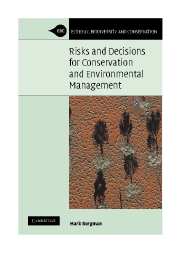Book contents
- Frontmatter
- Contents
- Preface
- Acknowledgments
- 1 Values, history and perception
- 2 Kinds of uncertainty
- 3 Conventions and the risk management cycle
- 4 Experts, stakeholders and elicitation
- 5 Conceptual models and hazard assessment
- 6 Risk ranking
- 7 Ecotoxicology
- 8 Logic trees and decisions
- 9 Interval arithmetic
- 10 Monte Carlo
- 11 Inference, decisions, monitoring and updating
- 12 Decisions and risk management
- Glossary
- References
- Index
3 - Conventions and the risk management cycle
Published online by Cambridge University Press: 03 December 2009
- Frontmatter
- Contents
- Preface
- Acknowledgments
- 1 Values, history and perception
- 2 Kinds of uncertainty
- 3 Conventions and the risk management cycle
- 4 Experts, stakeholders and elicitation
- 5 Conceptual models and hazard assessment
- 6 Risk ranking
- 7 Ecotoxicology
- 8 Logic trees and decisions
- 9 Interval arithmetic
- 10 Monte Carlo
- 11 Inference, decisions, monitoring and updating
- 12 Decisions and risk management
- Glossary
- References
- Index
Summary
Sit in a room of engineers and listen as they plan a risk assessment, and you'll hear a view of how it should be done. Sit in a room of ecotoxicologists, epidemiologists or conservation biologists and you'll get quite a different view. So different, in fact, that you might think the four groups were discussing four different topics. The assumptions, methods for data collection, models, use of experts and so on would differ from group to group. Some would be wildly different, although it would be difficult to tell through the blankets of jargon.
Some terms are useful in setting up a broad, common context for risk assessment.
A hazard is a situation that in particular circumstances could lead to harm (Royal Society 1983).
Stressors are the elements of a system that precipitate an unwanted outcome.
Environmental aspects are human activities, products or services (such as emissions, chemical handling and storage, road construction) that can interact with the environment (Zaunbrecher 1999).
An environmental effect is any change to the environment, whether adverse or beneficial.
These definitions help to describe activities and their relationships to detrimental (and advantageous) environmental outcomes. Management goals embody social values and management aspirations. Stressors and environmental aspects have effects on (consequences for) valued ecological attributes, processes and services. The broad scope of environmental aspects makes them valuable in organizing ideas for assessing complex operations. Table 3.1 provides some examples of these terms for an assessment of an irrigated catchment.
- Type
- Chapter
- Information
- Publisher: Cambridge University PressPrint publication year: 2005



